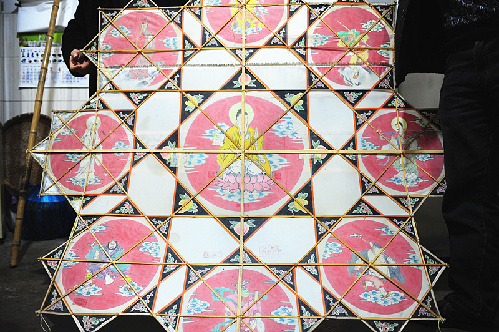Shazhou Banyao whistling kites in danger of vanishing
( chinadaily.com.cn )
Updated: 2015-04-24
|
|||||||||
Feng Taigen, 68 years old, is an inheritor of Shazhou Banyao whistling kites in Leyu town, Zhangjiagang, Jiangsu province. The whistling kite has been listed as a provincial intangible cultural heritage.
 |
|
Feng Taigen is among a few kite artists specializing in making the traditional Banyao Kite in Leyu town, in Zhangjiagang, Jiangsu province. [Photo provided to chinadaily.com.cn] |
There are different varieties of kites in China, such as hard-wing kites whose wings are reinforced on both the front and the back in the shape of swallows and eagles; soft-wing kites which flutter freely in the wind and take the shapes of butterflies, dragonflies and fish; and hard-board kites, including Shazhou Banyao whistling kites which Feng is most adept at producing.
Banyao - "ban" meaning board and "yao" meaning snipe – is a large, flat, whistling kite featuring a hexagonal frame adorned with exquisite decorations and vibrant colors.
As a kite specialist, Feng started to make kites since his childhood. His home is filled with various finished and unfinished kites in different sizes. "Banyao kites are different from the normal ones; they are more exquisite and elegant," said Feng. "The highlight of whistling kites is that they produce different sounds, like playing a concert as they dance among the clouds. You can hear them before you see them," he added.
It usually takes Feng more than 10 days to make a Banyao kite. The process of making a kite requires a high degree of expertise. There are five basic steps involved in the making of the kite: sizing, framing, covering, painting and flying.
The first task is to decide the size of the kite, after which the kite's frame is fashioned out of bamboo strips. Each bamboo batten should be made to have the same width and thickness. After the bamboo frame is constructed, the kite will be covered with nylon fabric containing the images of immortals or figures from folk tales.
 |
|
A kite's frame is fashioned out of bamboo strips and each bamboo batten should be made to have the same width and thickness. [Photo provided to chinadaily.com.cn] |
The whistles are made from dried gourds with a slit carved into the top. After receiving a coat of paint or gloss, they are lashed to the bamboo frame on the front of the kite. Each kite will typically be installed with dozens or even hundreds of whistles. Feng can make up to eight whistles each day.
Generally, a kite is flown by one person, but due to the large size of Banyao kites, which usually reach two to three meters in diameter, they often require up to four strong men to get the kites in to the sky and pull the strings and can only be flown in strong winds.
The bright colors and the whistles represent aspirations and expectations for a happy life. Many Chinese consider it beneficial to one's health to fly kites in spring as it allows people to enjoy the sunshine, fresh air and blue sky in a relaxing environment.
 |
|
A kite is covered with nylon fabric containing the images of immortals or figures from folk tales. [Photo provided to chinadaily.com.cn] |
The local government has been striving to support the traditional kite-making technique, but Feng is not so confident about the future of the heritage. Feng said that he was worried that it might vanish due to the lack of interest among the young generation to inherit the kite-making knowledge and pass it on." Those who know how to make the kites in Zhangjiagang are mostly over 60 years old," he said. "It will be really sad if, in the future, no one knows how to make them," he added.
Edited by Jacob Hooson







